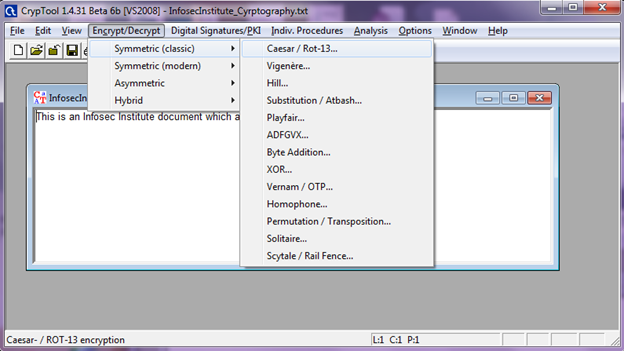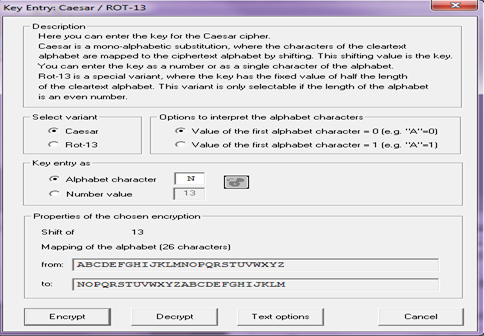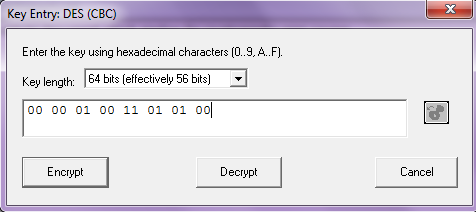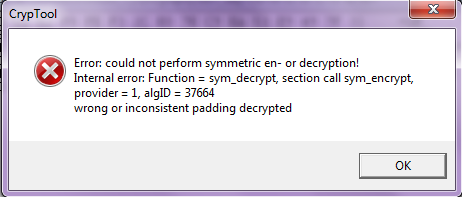Cryptography Fundamentals, Part 2 – Encryption
Encryption
These are the main types of encryption.
Symmetric Encryption:
A single key is used to encrypt and decrypt the message sent between two parties. Symmetric encryption is fast, and effective only when a key is kept absolutely secret between two parties.
Learn Applied Cryptography
[download]Download the Cryptography Fundamentals eBook (FREE)[/download]
Demonstration of Caesar Encryption using CrypTool
In this CrypTool demonstration, we will use Caesar, one of the oldest encryption algorithms.
Encryption
-
Open the Cryptool UI and the document that needs to be encrypted.

- Click Encrypt/Decrypt > Symmetric (classic) > Caesar

-
Select Caesar mode and the "alphabet character" is "N." That means that the text will have characters replaced starting with N. So A >N, B>M, and so on. Click on "encrypt."

- The document is encrypted as per the configured policy. This is a very basic example of how symmetric encryption works.

Decryption process
Perform the following steps to decrypt the encrypted document.
- Open the encrypted document, and click on "Encrypt.Decrypt" >Symmetric >Caesar.
- Enter "N" as the alphabet character. This is the shared secret that both parties must know in order to encrypt and decrypt.
- Click on decrypt.

Block Cipher
Block cipher is the process in which n- bits of plaintext is converted into n-bits of ciphertext using x-bits of key with block ciphers, message encryption and decryption happens in blocks. The most common mode of operation is cipher block chaining.

Source: Wikipedia
In this mode of operation, an initialization vector is needed, which is used to perform a XOR operation on plaintext. The XOR function takes two inputs and produces one result. Below is a brief explanation on how Bitwise XOR operation works.
As we can see in the above chart in XOR operation, Same bits (0-0 , 1-1) results in an output bit of 0 and different bits (0-1,1-0) results in an output bit of 1.
After the XOR operation, IV is then encrypted with the key to produce a block of ciphertext. The same ciphertext block is used to perform an XOR operation with next block of plaintext and so on. In the decryption process, for the first block the ciphertext is decrypted using the key, and XORed using the same IV to produce the first block of plaintext. For the remaining blocks, after the first ciphertext is decrypted, it is then XORed with the previous block of ciphertext to produce the final block of plaintext.
Other examples of block cipher modes are electronic codebook (ECB), propagating cipher block chaining (PCBC), cipher feedback (CFB), output feedback (OFB), and counter (CTR). I encourage users to understand these modes to gain a good understanding of block ciphers.
Here's a demonstration of a DES cipher in CBC mode.
About Data Encryption Standard (DES): DES is the archetypal block cipher — an algorithm that takes a fixed-length string of plaintext bits and transforms it through a series of complicated operations into another ciphertext bitstring of the same length. In the case of DES, the block size is 64 bits. DES also uses a key to customize the transformation, so that decryption can supposedly only be performed by those who know the particular key used to encrypt. The key ostensibly consists of 64 bits; however, only 56 of these are actually used by the algorithm. Eight bits are used solely for checking parity, and are thereafter discarded. Hence the effective key length is 56 bits, and it is always quoted as such.
Demonstration of DES(CBC) using CrypTool
In this section, we will perform DES encryption in CBC mode.
- Click on Encrypt > Symmetric (modern) > DES (CBC).
- Enter a hexadecimal character between 0-9,A-F to perform encryption, and click on encrypt.
- Change any bit with the selected hexadecimal character. In the image below I have selected the characters '0' and '1'.

- Here's the encrypted document.

Now perform decryption.
- Click on Click on Decrypt > Symmetric (modern) > DES (CBC).
- Click on decrypt.

What happened? Did you get this error message?

The error is because the key used for encryption and decryption is not the same.
For encryption we used: 00 00 01 00 11 01 01 00
For decryption we used: 00 00 00 00 00 00 00 00
This proves that both the parties must possess same secret key.
Now put the same key in to decrypt the document.
Stream Cipher
A stream cipher is a symmetric key cipher where plaintext digits are combined with a pseudorandom cipher digit stream (keystream). In a stream cipher each plaintext digit is encrypted one at a time with the corresponding digit of the keystream, to give a digit of the ciphertext stream. There are various examples of stream ciphers, like RC4, AES etc. The procedure for encryption and decryption for stream ciphers is the same as is done for block ciphers.
Block Ciphers vs Stream Ciphers
The below section will illustrate the main advantages and disadvantages of stream and block ciphers.
- Since stream ciphers work bit by bit, stream ciphers are faster than block ciphers.
- Since block cipher work on block of data, so it requires more memory for computation than stream cipher.
- One of the biggest advantage of block ciphers over stream ciphers is that they do not require padding.
- Because block ciphers encrypt a whole block at a time (and furthermore have "feedback" modes which are most recommended), they are more susceptible to noise in transmission, that is if you mess up one part of the data, all the rest is probably unrecoverable. Whereas with stream ciphers are bytes are individually encrypted with not connection to other chunks of data (in most ciphers/modes), and often have support for interruptions on the line.
- stream ciphers do not provide integrity protection or authentication, whereas some block ciphers (depending on mode) can provide integrity protection, in addition to confidentiality.
Asymmetric Encryption
A pair of keys is used to encrypt and decrypt the message. The pair of keys are public and private keys. Private keys are kept secret, known only by the owner, and the public key is visible to everyone. A and B want to communicate using asymmetric encryption. Below are the steps that happen in asymmetric encryption.
Sounds like a good solution! Well as far as secrecy is concerned it is, but when it comes to real world applications, asymmetric encryption is pretty slow. The keys involved in this process can be as large as 1024 bits or more. After the initial handshake, for subsequent requests even more overhead is incurred. What can we do? A hybrid approach is used, called public key infrastructure (PKI), which we will discuss later. First let's see how asymmetric keys are generated, using CrypTool.
We'll generate asymmetric keys using the RSA algorithm. RSA keys are generated with prime numbers.
Demonstration of Asymmetric Keys using CrypTool
- First, we'll create RSA keys. Click on "Indiv procedures" >PKI >Generate keys.
-
Select the RSA algorithm, with a bit length of 1024.
- Enter the details for the key pair to be created. They are the public and private key pair.
-
Click on Generate key pair.

-
This message will appear if you're successful.

-
Click on "Show Key Pair" to see the key pair and the associated public certificate. The public certificate of the key pair is shown below.

To enable RSA encryption:
-
Click on Encrypt > Asymmetric >RSA encryption.
-
Choose the previously created key and click on Encrypt.

- Here's the encrypted document.

To decrypt:
Learn Applied Cryptography
-
Click on Decrypt > Asymmetric >RSA decryption.
- Select the key pair to be decrypted and provide the key used during generation.

-
Click on decrypt.







